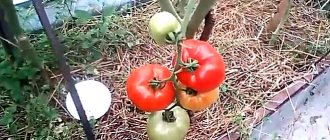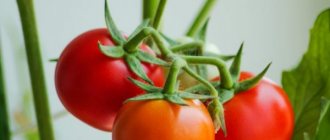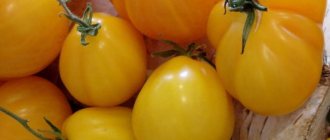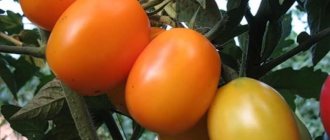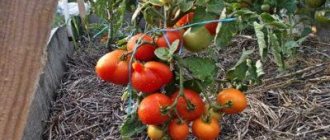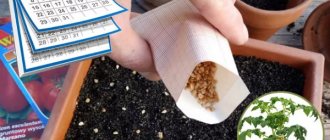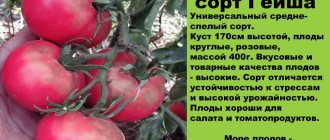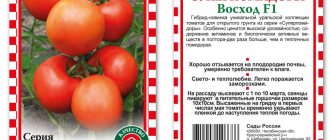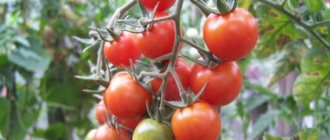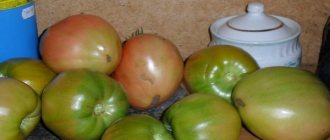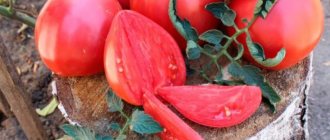A wide variety of tomato varieties are grown in Russian gardens. Not so long ago, from Western countries, we received miracle tomatoes - beefsteak tomatoes, Americans call them beef tomatoes. These are hybrid varieties characterized by enviable size and “health”.
Our gardeners quickly fell in love with them for their excellent taste and resistance to unfavorable growing conditions. In this article we will talk about Big Beef tomatoes, a description of the variety and the characteristics inherent in this tomato.
Description of the tomato variety
“Big Beef” tomatoes are an indeterminate (with unlimited growth), early maturing, disease-resistant hybrid, native to the warm and humid summer country of Holland. This variety has the following characteristics:
- the bush is strong, powerful, can reach a height of up to 2 m. Due to its height, it requires obligatory garter and support;
- The hybrid is early ripening, the period of fruit ripening from the beginning of planting is 98–100 days;
- the plant requires formation into 1 stem and removal of side shoots (small stepsons up to 3-4 cm);
- Tomato leaves are large in size, light green in color, with a small edge. The shoots are strong and strong, capable of holding large, massive fruits;
- the inflorescence is simple, formed on leaves 8-9;
- 4-5 fruits can ripen on one cluster;
- The yield of the variety is quite high, from 1 m², under the conditions of proper agricultural technology, you can harvest about 9 kg of tomatoes;
- the fruits are large, weighty, flat-round in shape, have a traditional rich bright red color, and can reach a weight of up to 200–300 g. Some specimens grow up to 2 kg;
- the taste of the fruit is pleasant, sweet with a slight sourness;
- the pulp is dense, juicy, fleshy;
- the tomato peel is shiny, thin, but resistant to cracking;
- Suitable for fresh consumption, as well as for preparing ketchups, sauces, tomato paste and salad preparations for the winter.
Growing tomatoes
The review variety is grown by planting seedlings in a greenhouse or unprotected soil.
How to prepare seeds?
For planting seedlings, it is necessary to select only whole and undamaged seeds. Planting material does not require disinfection, since it undergoes all necessary processing before sale.
REFERENCE: For better germination, some gardeners soak seeds for several hours in biogrowth stimulants.
Sowing seed material
For germination, planting material needs light and nutritious soil. Seeds are usually planted for seedlings in March. Plastic boxes, containers or other containers are filled with soil, into which the seeds are placed to a depth of 1.5 to 2 cm.
The future seedlings are sprinkled with warm water and covered with film (thin glass).
It is necessary to germinate seeds in a room with a temperature of 23-35 degrees Celsius.
After the sprouts appear, the film or glass covering is removed, and the containers are placed in a place well lit by sunlight. After several true leaves appear, the seedlings are planted in separate pots.
Rules for planting seedlings
Seedlings are planted in greenhouses or garden beds in early May. The plants are placed in medium-depth holes, at the bottom of which there is sifted wood ash or superphosphate.
Beef tomatoes:
Since the indeterminate bush grows up to 2 meters in height, it must be tied to a trellis. Therefore, the recommended planting scheme is no more than 3 plants per 1 square meter. meter
Advantages and disadvantages of the variety
- “Big Beef F1” tomatoes boast many advantages:
- early ripening;
- high resistance to almost all diseases that affect tomatoes, in particular late blight, nematode, fusarium, tobacco mosaic;
- resistance to environmental conditions, including low temperatures;
- excellent taste of fruits, their transportability;
- When properly stored, the fruits do not lose their juiciness and nutrients for 3 weeks.
- Among the disadvantages of tomatoes are:
- some difficulty in growing, since uncomfortable conditions negatively affect the yield of the plant;
- large fruit sizes that are not suitable for pickling and canning in whole fruit form;
- the plant requires frequent feeding;
- the impossibility of obtaining seeds from personally grown tomatoes due to the fact that the variety is a hybrid.
Big Beef History
The Dutch agricultural company MONSANTO HOLLAND BV is known on the market as a developer of products and tools for the efficient cultivation of crops. In particular, she is the originator of several varieties of beef tomatoes, including the Big Beef variety. In the spring of 2008, the company submitted an application to the State Commission of the Russian Federation for Testing and Protection of Breeding Achievements for the Big Beef tomato to undergo variety testing. In the same year, the variety was included in the State Register of varieties approved for cultivation in the Northern, Northwestern, Central, Central Black Earth, Volga-Vyatka, Middle Volga and North Caucasus regions. It is recommended to cultivate these tomatoes in private farms under film covers . Tomato seeds of this variety can now be purchased from various companies that sell seed materials.
Big Beef tomato seeds can be purchased from various growers.
What are Beef tomatoes - video
Features of planting and growing
Experts recommend growing this variety of tomatoes in greenhouses, since the ideal conditions for plant ripening are: average temperatures of + 18 ° C and fairly high humidity.
Important! Tomatoes are grown in open ground only in the southern regions, where a warm and humid climate prevails. The variety is adapted to certain conditions, so it does not tolerate sudden temperature changes.
Optimal conditions
Optimal conditions in a greenhouse have a beneficial effect on plant growth, the formation and development of fruits, and their resistance to disease. The main factor adversely affecting yields is sudden temperature changes.
Therefore, when growing Big Beef, the following conditions should be observed:
- Temperature. Temperatures should fluctuate between + 18...+20 °C, while the night temperature should not drop below + 15 °C. Drafts or exposure of plants to direct sunlight are not allowed.
- Lighting. Tomatoes should be grown in plenty of light, at least 12 hours of light, otherwise their development will be stunted, which will negatively affect yields. In the absence of proper lighting, it is recommended to install additional fluorescent lamps.
- Humidity. It is recommended to grow tomatoes in conditions of high humidity, about 70%, but at the same time avoid the formation of dampness.
Preparing for sowing
Tomatoes should be planted in early spring. Before this, it is recommended to soak the seeds in water and then place them in a container where the seedlings will be grown - disposable plastic cups, peat tablets, special containers. It should be noted that seeds purchased in specialized stores do not need disinfection, so they can be planted ready-made.
After sowing the seed, the containers are covered with film until the first shoots appear. As soon as the first leaves appear, the seedlings need to be pricked. Experts also recommend disinfecting the soil before sowing by treating it with a strong solution of potassium permanganate or heating the soil in a microwave oven for 1-2 minutes at a power of 850 W.
Did you know? The name “tomato” is translated from Italian as “golden apple”. But the real name “tomatl” was among the Aztecs. This is what the French started using “tomate”.
Sowing technology
Traditional technology for sowing seeds for seedlings:
- containers for planting must be filled with soil and small depressions up to 1 cm must be made in the soil;
- Place seeds in each hole, pressing them slightly into the ground;
- the distance between the beards should be about 3-4 cm, and between the holes - 1-2 cm;
- the planted seeds should be sprinkled with soil and the surface should be sprinkled with water from a spray bottle;
- Containers with future seedlings should be covered with film and placed in a warm, dry place.
At the first shoots, it is recommended to remove the film.
Planting seedlings in a permanent place
Planting of seedlings in a permanent place is carried out 55 days after the first shoots, in early May, when there is no risk of frost.
It is carried out using the following technology:
- Soil preparation. Before planting seedlings, the soil must be fertilized using peat, wood ash and superphosphates. It is also necessary to loosen the soil well and moisten it.
- Landing scheme. Since tomatoes are quite large, large areas are required for their full growth and development. The optimal planting scheme is considered to be: 2-3 bushes per 1 m².
- Hydration. After planting the seedlings, it is recommended to moisten the soil with settled water at room temperature.
When growing tomatoes outside, they should be staked immediately after planting.
Did you know? The largest tomato was grown in the US state of Washington. The weight of the fetus was 2.9 kg.
Growing seedlings
Sowing work begins in late February-early March, 55-60 days before planting in the ground. Pre-prepare containers and soil.
Soil preparation and sowing
Hybrid seeds do not need to be treated with anything; the manufacturer has taken care of this.
For sowing, universal soil for seedlings or prepared by yourself is suitable . To do this take:
- 1 part peat;
- 1 part humus;
- 1 part turf;
- 1 part river sand;
- 1 tbsp. l. wood ash;
- 1 tbsp. l. superphosphate.
It is advisable to disinfect the soil by heating it in the oven or watering it with a solution of potassium permanganate. Next, the substrate is moistened and filled into containers 5-7 cm high with drainage holes at the bottom to drain excess water.
Make grooves 1.5 cm deep in the soil and lay out the seeds at intervals of 2 cm . Sprinkle a 1 cm layer of soil on top, water with a syringe and cover with polyethylene. The containers are placed in a dark place, the film is removed daily for 15-20 minutes for ventilation. Shoots appear at a temperature of +22 °C after five days, at 25 °C after three days.
For sowing seeds, a method that does not involve picking is often used . To do this, take special thick bags from gardening stores or tall plastic glasses. Fill the containers with soil and lay out two seeds. Cover with film and wait for shoots.
Seedling care
When sowing seeds in general containers, the sprouts are planted in peat cups or other containers after 4-5 true leaves appear. The seedlings are placed on a windowsill with sufficient lighting.
If the seed was immediately sown in separate glasses , the strongest one is selected from the two sprouts that appear, and the weak one is removed. The soil is replenished as the seedlings grow.
The optimal temperature for the growth of strong seedlings is +20 °C during the day, and +15 °C at night . If there is not enough light, install phytolamps. The longer the daylight hours, the better - the seedlings do not stretch out and gain strength faster.
The soil is moistened moderately using a syringe or syringe, pouring water under the root.
Before planting in the ground, tomatoes are hardened . Every day, the seedlings are taken out into fresh air and left for two hours. The time is gradually increased to 24 hours.
About other varieties of large-fruited tomatoes:
Why is the Beef Pink Brandy F1 tomato so good?
Large-fruited sweet tomatoes “Pink Giant”
Tomato care
Timely and competent care of tomatoes is the basis for a good and rich harvest. The rules for caring for the plant are traditional; they consist of high-quality watering, fertilizing and treating the bush with disinfectants against possible parasites and pests.
Fertilizer and watering
Tomatoes of this variety require more intensive feeding than others. Without regular application of mineral fertilizers, you should not count on a high fruit yield. It should also be noted that potassium fertilizers should be twice as dominant as nitrogen fertilizers, since the latter stimulate the growth of greenery, but at the same time have a negative effect on the growth of fruits.
Tomatoes should be watered regularly as the soil dries. Watering is mandatory during the period of plant flowering, fruit formation, and after loosening and weeding. Experts recommend organizing drip irrigation in greenhouse conditions, through which you can control the degree of soil moisture. Water the bushes directly into the holes, at a rate of at least 700–900 ml of liquid per bush.
Bush formation and pinching
The “Big Beef” variety requires the formation of a bush, preferably 1 stem. To obtain a high yield, it is necessary to leave 4-5 ovaries and remove the rest. It is recommended to carry out pinching - removal of lateral processes - every 7-10 days. Periodically, every 10 days, it is necessary to trim the lower leaves, which “take away” nutritional components from the fruit, thereby slowing down their growth. If you do not carry out the pinching procedure, then the tomato fruits will be small or deformed.
Important! If there is a need to obtain large, large fruits weighing over 300 g, then only 3 ovaries should be left on the plant.
Loosening the soil and weeding
A mandatory procedure when growing tomatoes is loosening the soil, which allows you to:
- saturate the soil with oxygen and nutrients;
- create comfortable conditions for good soil heating;
- activate metabolic processes, thereby accelerating plant growth.
The first loosening is recommended to be carried out immediately after planting the seedlings.
It is carried out deeply, up to 10–12 cm. Subsequently, loosening is done systematically, if necessary, going 4-5 cm deep into the ground. Along with loosening the soil, weeding is carried out to remove weeds. The presence of a large number of weeds negatively affects the growth and development of the bush, which leads to a deterioration in its yield. Did you know? Red tomatoes contain more nutrients and vitamins than yellow tomatoes.
Diseases and pests of tomatoes
One of the most significant advantages of the Dutch variety of tomatoes is their high resistance to diseases: late blight, fusarium, cladosporiosis, nematode, tobacco mosaic, gray spot , etc. However, if the rules of agricultural technology are not followed, even such resistant tomatoes can be affected by bacteria and various ailments. To prevent this from happening, it is recommended to carry out a number of preventive measures:
- regular loosening and digging of the soil;
- preventive treatment of bushes against parasites;
- timely removal of weeds from the soil;
- sprinkling the soil with wood ash to prevent the development of diseases;
- treatment of bushes with a solution of copper sulfate 21 days before harvest.
The condition of the plant can be negatively affected by:
- excessive watering;
- sudden temperature changes;
- prolonged exposure to direct sunlight;
- excessive dry air.
Harvest and storage times
Tomatoes are harvested from the end of July until the first weeks of September. The fruits are collected for the purpose of their further storage together with the stalks and slightly unripe ones. To consume tomatoes fresh for food, they are picked completely ripe. Store tomatoes in a warm, dry place, away from moisture and dampness. The fruits are stored without losing their nutrients and beautiful appearance for about 3 weeks.
Find out how often and how correctly to water tomatoes in a greenhouse.
The “Big Beef F1” variety will be a worthy option for those who highly value such indicators as productivity, high resistance to diseases, early ripeness and excellent taste of fruits. Despite the fact that the hybrid came to us from abroad, subject to the basic rules of agricultural technology, even a novice gardener can achieve high yields of tasty and healthy tomatoes.
